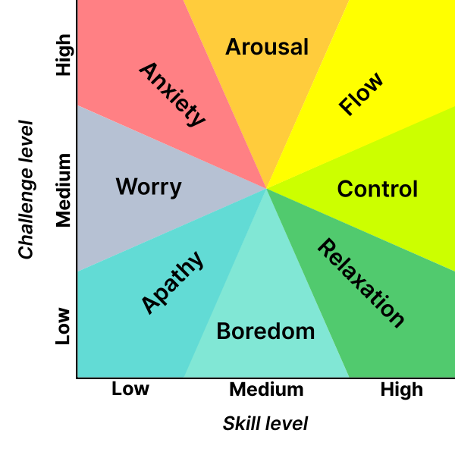Flow
You’ve probably heard of flow. That perfect balance of concentration, energy, attention, and understanding that leads to progress. You’ve probably been in a flow state a few times. It seems magical. You get more done than you expected and when you’re done the result feels right. Everything seems to click and the code is something you’re proud of.
And it’s by no means restricted to development, or just creative endeavors, but also in repetitive, assembly line, types as well. One of my early jobs was at a concrete block factory. Everything from running the molding machine to loading trucks, and pretty much everything in between.
There was a lot of automation, but we also did a bunch of semi-custom work that added manual steps to the process. Particularly the part of putting the finished blocks into cubes on pallets so they could be stored in the yard or loaded for shipment. Some of the patterns we needed to use so the blocks interlocked and didn’t fall off when the truck went around a corner were complicated.
Even worse, some of them were rough split, so we had to keep pairs together so they fit well. Some days running the cuber was a struggle. Getting things in just the right place as more blocks kept flying down the line was hard. It felt like Lucy in the candy factory. Nothing seemed to go smoothly and eventually we’d either have to get more people at the cuber or hit the pause button and get caught up. Other days it, with the exact same kind of blocks, and the machine running at the exact same speed, things would just flow.
More relevant to us though is flow as a developer. I think this is an urban legend, but the XKCD page on the Ballmer Peak is real. And there’s certainly truth to the idea of reducing inhibitions to increase creativity. Pretty sure blood-alcohol-content isn’t the best way to get that increase, and stress and anxiety make things worse. So what does go into enabling flow?
The most common way of looking at it is to compare how your skill level at a task compares to the challenge of the task. Seems reasonable. With the caveat that your skill level at a task has an inverse, but non-linear, relationship to how much of a challenge it is. For any given task, the better at it you are, the less of a challenge it will be. The current model looks a lot like

To me that just looks like a color wheel though. It’s visually round, which seems odd, and oddly specific. The sharp boundaries between states just doesn’t feel right.
What does feel right, to me at least, is a much older version of that image.

It’s the same author, but 40+ years older. It could probably do with a little more detail on the areas outside of flow, but for visualizing the difference between flow and not flow, I think it captures the real driver, which is a proper balance of skill and challenge. It might be hard to do, but you know you can do it, or it might be easy, and you can do it very easily. Either way, there’s a balance.
That’s why we like flow. Not because the task is easy, but because the mental state is easy. There’s no anxiety, boredom, worry, or apathy to deal with. All of your mental energy can go into accomplishing the task. Which also explains why so much gets done.
But here’s the catch. Flow is productive, but it’s often not growth. At all but the highest challenge/skill levels, you’re doing things that you know how to do. There will be incremental improvement, but to really make a step change to your skill/ability, you need to challenge yourself to go beyond your skill level. And there’s no flow there.
